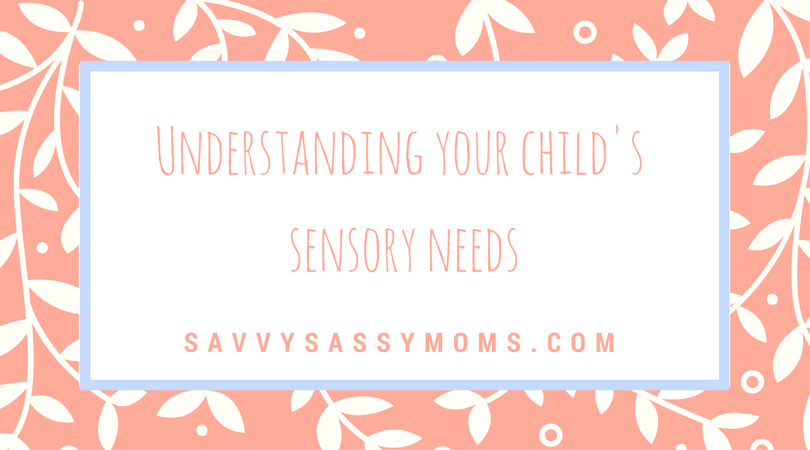Have you ever experienced your child having a meltdown in public that left you with a feeling of utter embarrassment? Or caught yourself repeatedly telling them to “sit still” and stop squirming? Many children go through developmental stages that make it challenging to regulate their emotions and behaviors. Parents who may not understand their child’s sensory needs feel frustrated during those times.
Recognizing sensory needs in different situations
Some challenging behaviors may be evidenced as a baby or a toddler. Various situations emerge that cause extreme reactions from your child and some maybe easier to explain than others. Many children, and adults, cringe at hearing the loud sound of hand dryers in public washrooms or want to have the tags cut out of clothing. But how do you explain the constant invading of personal space or the need to touch things? The more we as parents are aware and understand the sensory processing needs of our children, the less upset they will be and the less frustrated we will become!
Understanding Sensory Processing Disorder (SPD)
Sensory Processing Disorder (SPD) is when there is an over or under reaction to processing input from the senses. Most people are familiar with the five senses (sound, sight, smell, taste and touch), but did you know that we actually have seven sensory systems? You may not have heard of the senses called vestibular and proprioceptive. The vestibular system has to do with balance and movement while the proprioceptive system involves body awareness and where one is in space. The SPD Foundation research has found that 1 in 20 children experience symptoms of Sensory Processing Disorder that are significant enough to affect their ability to participate fully in everyday life. (Autism Awareness Centre Inc.). Clear definitions of each sensory system are available on therapystreetforkids.com
Many children who have a diagnosis of Autism Spectrum Disorder (ASD), Learning Disabilities (LDs), and Attention Deficit Hyperactive Disorder (ADHD) may also have related sensory concerns. Even without a diagnosis, SPD is very real for a large number of children. Check out this video from a young boy who explains firsthand what it is like to have sensory processing issues and what helps him.
Don’t we all have individual preferences for different sensory input?
Sure, not everyone loves the taste and texture of onions or can wear a wool sweater on their bare skin (ugh the itch!!!), but SPD is MORE than a preference. For example, does your child have a strong gag response to certain foods or smells that most people would not consider offensive? Did you buy the “wrong” pair of socks again that causes your child and the morning routine to be in shambles? Does your child have a high tolerance for pain or is not coordinated to ride a bike? These may be indicators that your child presents with Sensory Processing Disorder (SPD).
Children with SPD have trouble navigating their responses to the seven senses and as a result exhibit behavior that you may find difficult to manage. Without support, this may then lead to negative consequences in a child’s:
- academic learning
- social interactions
- family dynamics
- ability to self-regulate
- confidence and self-esteem
If you may be wondering about your own child, checkout this useful reference: http://u.org/2C9P0rD
Ways parents can help with various sensory needs
The first step is to carefully observe your child in different environments to note their behaviors, and what’s going on around that behavior (e.g., just avoidance or meltdowns if put on a swing?). You may also want to speak to their teachers or others who have regular contact with your child to see if these concerns are also observed in those environments. If you are unsure a good tool is the Symptoms Checklist by the STAR Institute. Observational lists are sorted by age and available for free online, and appropriate for a parent or teacher to use. As a next step, arrange a meeting with your pediatrician to discuss your concerns.
We all know that exercise is important, so parents should consider a regular extracurricular class that improves body awareness, gross motor skills and movement. Make choices based on your child’s interest versus a competitive team sport.
Create a safe space for your child
With time, support and patience, kids with SPD may develop their own coping skills. You can help guide them through a meltdown by creating a “chill out” area in your home. It should be an area that is relatively quite and free of clutter. In the area you can place a “calm box” with various items that are self soothing to your child (e.g., blanket, silly putty, books, headphones, etc.). You and your child can even go shopping together for items they find calming. It is important to use the “chill out” area not as a form of punishment, but as a place to self-calm and regulate their emotions.
The next time you are feeling your frustrations rise as your child refuses to wear the 3rd pair of socks you bought, take a deep breath, and understand that this is a very real challenge for them. If they prefer at that moment, let them go sockless!
Resources:
- The Out-of-Sync Child: Recognizing and Coping with Sensory Processing Disorder (The Out-of-Sync Child Series) by Carol Kranowitz
- Building Bridges Through Sensory Integration by Paula Aquilla and Ellen Yack
- Arnie and His School Tools: Simple Sensory Solutions that Build Success by Jennifer Veenendall
- Why Does Izzy Cover Her Ears? Dealing with Sensory Overload by Jennifer Veenendall
References:
- https://www.sensory-processing-disorder.com/
- https://www.understood.org/en
- https://www.brainbalancecenters.com/blog/2014/01/sensory-processing-disorder-or-adhd/
- therapystreetforkids.com
- https://www.spdstar.org/basic/symptoms-checklist
- https://autismawarenesscentre.com/
Thank you to Nancy Farajun, (BA, MA, OT Reg (Ontario) ) for collaborating with Janet Arnold (Savvy Sassy Moms) on this article. Read more from Janet Arnold in her book: How to Explain a Diagnosis to a Child








